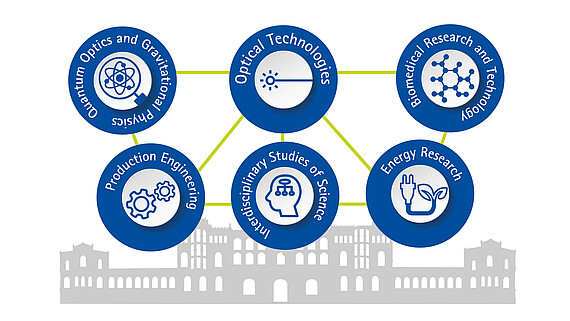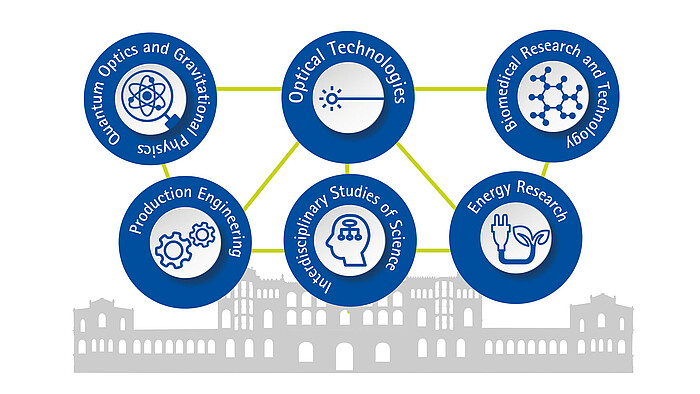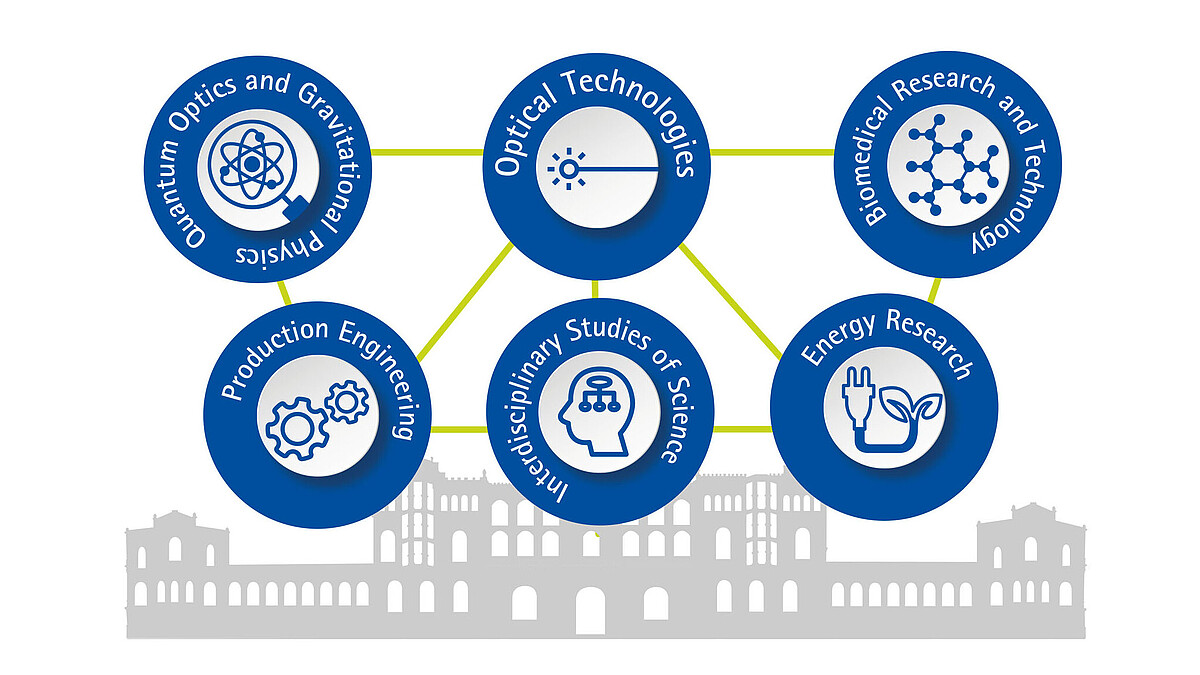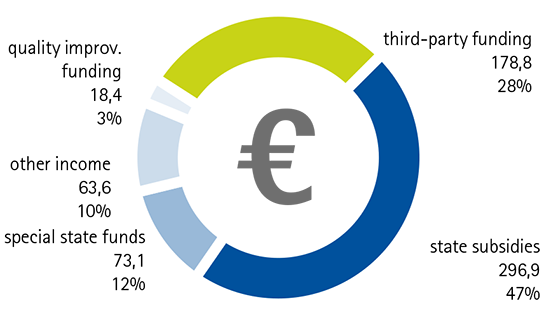Flyer
Degree programms
33 undergraduate degree programmes and 52 master’s degree programmes are available.
Including
- 10 degree programmes exclusively taught in English,
- 4 degree programmes with majors taught in English and
- 8 bilingual degree programmes.
Students
Number of students per winter semester



26,079 students are enrolled in winter semester 2024/25.
Number of students in previous semesters:
- 27,229 in winter semester 2023/24
- 28,018 in winter semester 2022/23
- 28,819 in winter semester 2021/22
- 29,433 in winter semester 2020/21
Info: 25,139 students were enrolled in summer semester 2024.
Students per faculty in winter semester 2024/25
| Faculty | total | female | international |
|---|---|---|---|
| Total | 26,079 | 4 % | 15 % |
Faculty of Natural Sciences | 2,997 | 53 % | 8 % |
| Faculty of Mathematics and Physics | 1,861 | 31 % | 17 % |
| Faculty of Electrical Engineering and Computer Science | 3,095 | 16 % | 33 % |
| Faculty of Mechanical Engineering | 2,751 | 20 % | 32 % |
| Faculty of Civil Engineering and Geodetic Science | 2,109 | 31 % | 27 % |
| Faculty of Humanities | 5,774 | 65 % | 5 % |
| Faculty of Architecture and Landscape Sciences | 1,530 | 63 % | 8 % |
| Faculty of Law | 2,491 | 62 % | 4 % |
| Faculty of Economics and Management | 3,321 | 36 % | 8 % |
| Other | 149 | 53 % | 1 % |
- 44 percent (11,377) of enrolled students are female.
- 15 percent (3,790) are foreign nationals.
(As of winter semester 2024/25, excluding students who have taken leave of absence; full-time equivalents)
Degrees
Number of graduates per type of degree



- 47 percent (2,212) are bachelor’s degrees.
- 49 percent (2,297) are master’s degrees.
- 4 percent (215) are law degrees (first state examination).
(In the academic year 2023)
Number of completed degrees per year



4,724 degrees have been completed in the academic year 2023. Degrees completed in previous years :
- 4,982 in the academic year 2022
- 5,040 in the academic year 2021
- 4,603 in the academic year 2020
- 4,855 in the academic year 2019
Graduates per faculty in the academic year 2023
| Faculty | total | female | international |
|---|---|---|---|
| Total | 4,724 | 46% | 14% |
| Faculty of Natural Sciences | 568 | 59% | 6% |
| Faculty of Mathematics and Physics | 309 | 34% | 6% |
| Faculty of Electrical Engineering and Computer Science | 513 | 14% | 37% |
| Faculty of Mechanical Engineering | 711 | 13% | 34% |
| Faculty of Civil Engineering and Geodetic Science | 315 | 37% | 23% |
| Faculty of Humanities | 1,092 | 73% | 2% |
| Faculty of Architecture and Landscape Sciences | 327 | 62% | 8% |
| Faculty of Law | 230 | 65% | 4% |
| Faculty of Economics and Management | 644 | 45% | 4% |
| Other | 15 | 44% | – |
- 46 percent (2,167) of degrees have been completed by female students.
- 14 percent (643) of degrees have been completed by foreign nationals.
(In the academic year 2023)
Research



Leibniz University Hannover holds a leading international position in six key research areas.
Outstanding research projects at Leibniz University Hannover
Staff
Members of staff by gender



- 57 percent (2,964) of staff members are male.
- 43 percent (2,265) of staff members are female.
(As of 1 December 2023)
Number of staff per year



As of December 2023, the university employed 5,229 members of staff. Staff numbers in previous years:
- 5,276 in 2022
- 5,294 in 2021
- 5,203 in 2020
- 5,138 in 2019
(Numbers issued on 1 December of the respective year)
Staff per faculty
| Faculty | total | prof. | WM * | MTV * |
|---|---|---|---|---|
| Total | 5,229 | 354 | 3,029 | 1,846 |
Faculty of Natural Sciences | 648 | 61 | 399 | 188 |
| Faculty of Mathematics and Physics | 492 | 60 | 339 | 93 |
| Faculty of Electrical Engineering and Computer Science | 398 | 33 | 304 | 61 |
| Faculty of Mechanical Engineering | 742 | 22 | 476 | 244 |
| Faculty of Civil Engineering and Geodetic Science | 447 | 25 | 294 | 128 |
| Faculty of Humanities | 560 | 78 | 384 | 98 |
| Faculty of Architecture and Landscape Sciences | 210 | 31 | 140 | 39 |
| Faculty of Law | 129 | 19 | 84 | 26 |
| Faculty of Economics and Management | 232 | 25 | 170 | 37 |
| Other | 1,371 | – | 439 | 932 |
* WM = research staff; MTV = technical and administrative staff
Please note:
Unless indicated, all numbers refer to employment. Employment reflects the duties of a natural person depending on the form of duties (e.g. research staff or administrative staff), the location (organisational unit) as well as on financing (e.g. budget funds or third-party funding). A natural person can be employed in multiple positions at the same time.
In 2023, 4,598 members of staff were employed in 5,229 positions. 1,914 (42%) of which were female and 2,684 (58%) were male. 623 (14%) were foreign nationals.
Junior researchers
Number of doctorates per faculty in 2023
| Faculty | total | female | international |
|---|---|---|---|
| Total | 372 | 31 % | 21 % |
Faculty of Natural Sciences | 82 | 44 % | 26 % |
| Faculty of Mathematics and Physics | 34 | 21 % | 26 % |
| Faculty of Electrical Engineering and Computer Science | 48 | 17 % | 33 % |
| Faculty of Mechanical Engineering | 58 | 10 % | 9 % |
| Faculty of Civil Engineering and Geodetic Science | 40 | 23 % | 38 % |
| Faculty of Humanities | 28 | 61 % | 11 % |
| Faculty of Architecture and Landscape Sciences | 8 | 60 % | 20 0% |
| Faculty of Law | 25 | 44 % | – % |
| Faculty of Economics and Management | 30 | 43 % | 13 % |
| QUEST Leibniz Research School | 19 | 26 % | 26 % |
- 117 (31 %) were completed by female students.
- 79 (21 %) were foreign nationals.
Between 2020 and 2024, 45 persons completed habilitation at Leibniz University Hannover.
- 13 (29 %) of which were female and 32 (71 %) were male.
- 9 (20 %) were foreign nationals.
Postdoctoral theses (Habilitationen) per faculty 2020-2024
| Faculty | total | female |
|---|---|---|
| Total | 45 | 13 |
Faculty of Natural Sciences | 9 | 4 |
| Faculty of Mathematics and Physics | 8 | 2 |
| Faculty of Electrical Engineering and Computer Science | 3 | – |
| Faculty of Mechanical Engineering | 5 | – |
| Faculty of Civil Engineering and Geodetic Science | 2 | – |
| Faculty of Humanities | 12 | 5 |
| Faculty of Architecture and Landscape Sciences | – | – |
| Faculty of Law | 3 | 1 |
| Faculty of Economics and Management | 3 | 1 |
Finances
Overall income in million €



The overall income of Leibniz University Hannover in 2023 included:
- 47 percent (296.9 million €) of state subsidies
- 12 percent (73.1 million €) of special funds provided by the state government
- 10 percent (63.6 million €) of other income
- 3 percent (18.4 million €) of quality improvement funding and tuition fees for long-term students
- 28 percent (178.8 million €) of third-party funding
(Income according to the 2023 earnings statement)
Development of third-party funding in million €



In the financial year 2023, Leibniz University Hannover acquired 178.8 million € of third-party funding. Third-party funding in previous years:
- 176.0 million € in 2022
- 157.1 million € in 2021
- 143.2 million € in 2020
- 130.0 million € in 2019
Sources of third-party funding in million €



- 36 percent (63.8 Mio. Euro) of funding provided by the German Research Foundation (DFG) and the Volkswagen Foundation (thereunder 0.9 million €)
- 26 percent (64.7 Mio. Euro) of federal funding
- 11 percent (19.4 Mio. Euro) of other third-party funding (e.g. DAAD)
- 6 percent (10.7 Mio. Euro) of funding from commissions
- 11 percent (20.2 Mio. Euro) of EU funding
(As of 2023)
Third-party funding per faculty in 2023
| Faculty | total (million €) | incl. DFG/VW Foundation | incl. EU/federal gov. |
|---|---|---|---|
| Total | 178.8 | 36 % | 47 % |
Faculty of Natural Sciences | 14.1 | 47 % | 37 % |
| Faculty of Mathematics and Physics | 19.0 | 16 % | 79 % |
| Faculty of Electrical Engineering and Computer Science | 15.0 | 22 % | 53 % |
| Faculty of Mechanical Engineering | 47.1 | 38 % | 45 % |
| Faculty of Civil Engineering and Geodetic Science | 21.5 | 35 % | 54 % |
| Faculty of Humanities | 7.9 | 42 % | 40 % |
| Faculty of Architecture and Landscape Sciences | 2.2 | 13% | 72 % |
| Faculty of Law | 0.6 | 15% | 65 % |
| Faculty of Economics and Management | 2.4 | 46 % | 24 % |
| Leibniz School of Education | 1.9 | – | 80 % |
| QUEST Leibniz Research School | 7.1 | 90 % | 0 % |
| Leibniz School of Optics and Photonics | 7.4 | 100% | 0 % |
| L3S Research Centre | 12.7 | 17 % | 79 % |
| Central facilities / general administration | 19.8 | 24 % | 32 % |
Locations and buildings
Largest locations
- Schneiderberg 108,900 m²
- Welfengarten 75,596 m²
- Garbsen 40,801 m²
- Königsworther Platz 33,504 m²
- Herrenhausen 30,400 m²
Largest buildings
- Main building (building 1101) 21,650 m²
- External bookstack in Rethen (building 6502) 17,009 m²
- Multi-story building Appelstraße (building 3408) 14,715 m²
- Experimental hall Marienwerder (building 8901) 13,979 m²
- WMR building on Appelstraße (building 3403) 11,798 m²
(Measured data in terms of floor space NUF 1-6, as of January 2023)




































